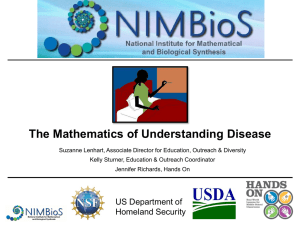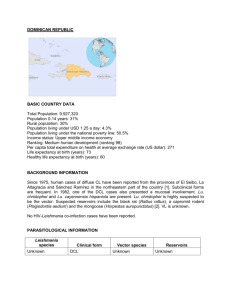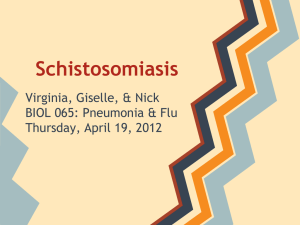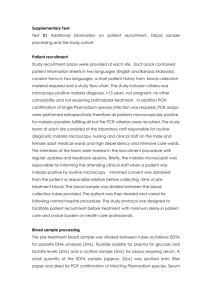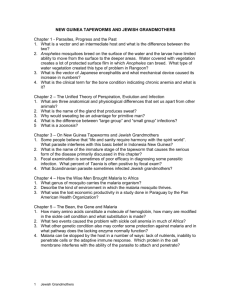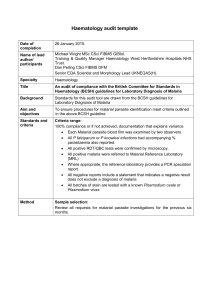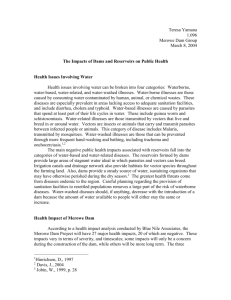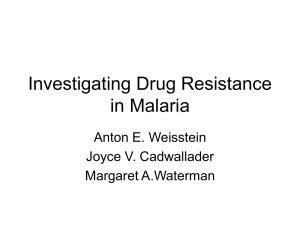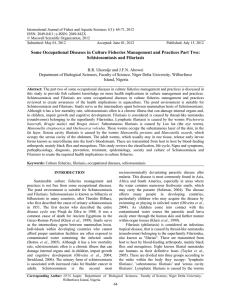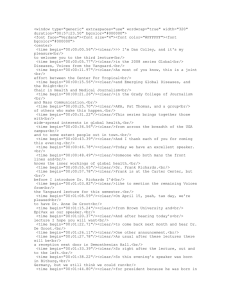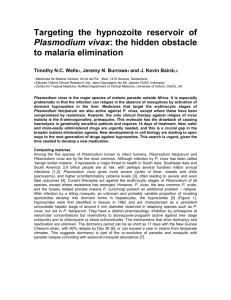1.Which of the following is correct (parasite
advertisement
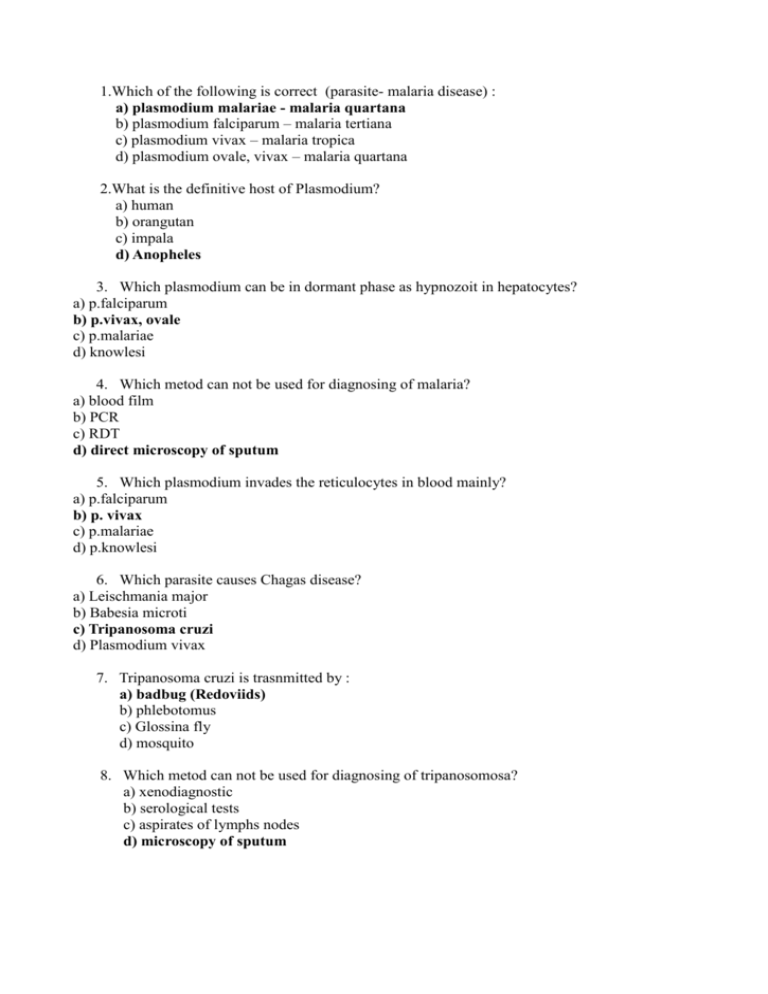
1.Which of the following is correct (parasite- malaria disease) : a) plasmodium malariae - malaria quartana b) plasmodium falciparum – malaria tertiana c) plasmodium vivax – malaria tropica d) plasmodium ovale, vivax – malaria quartana 2.What is the definitive host of Plasmodium? a) human b) orangutan c) impala d) Anopheles 3. Which plasmodium can be in dormant phase as hypnozoit in hepatocytes? a) p.falciparum b) p.vivax, ovale c) p.malariae d) knowlesi 4. Which metod can not be used for diagnosing of malaria? a) blood film b) PCR c) RDT d) direct microscopy of sputum 5. Which plasmodium invades the reticulocytes in blood mainly? a) p.falciparum b) p. vivax c) p.malariae d) p.knowlesi 6. Which parasite causes Chagas disease? a) Leischmania major b) Babesia microti c) Tripanosoma cruzi d) Plasmodium vivax 7. Tripanosoma cruzi is trasnmitted by : a) badbug (Redoviids) b) phlebotomus c) Glossina fly d) mosquito 8. Which metod can not be used for diagnosing of tripanosomosa? a) xenodiagnostic b) serological tests c) aspirates of lymphs nodes d) microscopy of sputum 9. Cutaneous leishmaniosis is mostly frequently caused by: A, L. major and L tropica in the Old World ( + ) B, L.major and L tropica in the New World ( - ) C, L. braziliensis, L. mexicana in the Old World ( - ) D, L. braziliensis, L. mexicana in the New World ( + ) 10. The time from an infective sand fly bite to the onset of visceral leishmaniasis is: A, typically from 2 to 6 months ( + ) B, can range from 2 weeks to more than 2 years ( + ) C, typically 2-5 days ( - ) D, typically from 10 to 15 years 11. Choose the correct answer: A; The diagnosis of cutaneous leishmaniasis relies on demonstration of Leishmania in tissue biopsy, scraping or impression preparations by microscopy and/or culture in a specialized medium ( +) B, For visceral leishmaniasis, definitive diagnosis requires the demonstration of the parasite by smear or culture in tissue ( + ) C , Serological tests can be used to demonstrate anti-leishmanial antibodies ( + ) D, Common clinical features of visceral leishmaniasis include chronical cough and bronchitis ( - ) 12. L. braziliensis : A, can cause destruction of the nasal septum ( + ) B, factors associated with higher risk of mucocutaneous leishmaniasis include malnutrition ( + ) C, usually causes visceral leishmaniasis ( - ) D, lymphadenopathy can occur, especially with species of the L. braziliensis complex ( + ) 13. Visceral leishmaniasis is usually caused by: A, L. donovani and L. infantum (L. chagasi) ( +) B, L. major and L. tropica ( - ) C, L. braziliensis, L. mexicana ( - ) D, sand fly ( - ) 14. Typical vectors for schistosomiasis are: a) ticks b) mosquitos c) snails (true) d) domestic cats 15. Typical manifestations of acute schistosomiasis include: a) Fever, liver and spleen damage, anaemia b) Abdominal pain, cough, diarrhoea, eosinophilia, hepatosplenomegaly (true) c) Abdominal pain, weight loss, anaemia, mucosal ulcers d) Fever, athralgia, vomiting, anaemia, jaundice 16. Most practical diagnostic method for identifying schistosomiasis is: a)Antibody detection b)Tissue biopsy c)Microscopic examination of blood d)Microscopic examination of stool and urine (true) 17. How much time is needed for the schistosomiasis parasites to reach maturity inside the human body? a) 2-3 weeks b) 3-5 weeks c) 6-8 weeks (true) d) 8-10 weeks 18. Current treatment of schistosomiasis is a) praziquantel (true) b) doxycycline c) chloroquine d)amphotericin 18. Which statement is true about Ascaris lumbricoides: a. Children are more frequently and more heavily infected than adults. (T) b. One of its signs is bloody diarrhoea. (T) c. The larva settle into the large intestine where they develop (F) d. Eggs passed out in stool are embryonated when they are infective (F) 19. Which statement is true about Trichuris trichura : a. The adult worm looks like a whip(T) b. Can cause anaemia (T) c. Treatment of trichuriasis is similar to filariasis(F) d. The worm has a lung passage phase(F) 20. Which of the following are intestinal helminths : a. Enterobious Vremicularis(T) b. Bancroftian Filariasis(F) c. Trichuris Trichura(T) d. Kala-azar(F) 21. Which statement is true about Enterobious Vermicularis : a. Commonly known as whipworm (F) b. The worm has a lung passage phase (F) c. Commonly known as pinworm (T) d. A child with Enterobiasis will have a history of severe puritus ani (T) 22. Which of these is true about intestinal helmiths: a. All of them have lung passage phase (F) b. Can infest in tissues too (F) c. Ascaris lumbricoides is one of them (T) d. Ascaris lumbricoides is known as tapeworm (F) 23. Which of the following statements about transmission of flukes (trematodes) are true: a) Schistosoma haematobium is transmitted by skin penetration of cercariae released from snails - T b) Fasciola hepatica is transmitted by ingestion of metacercariae on aquatic plants or in water -T c) Paragonimus westermani is transmitted by inhalation of eggs in bird droppings (feces) - F d) In infection with Clonorchis sinensis transmission occurs via promastigotes introduced through the proboscis of the female sandfly (genus Phlebotomus) into the skin -> a) true; b) true; c) false; d) false 24. Clonorchiasis and opisthorchiasis (Infection by biliary flukes) may be associated with manifestations such as: a) Rght-upper abdominal pain b) Acute renal failure c) Cholangiocarcinoma d) Biliary obstruction and related biliary hepatitis -> a) true; b) false; c) true; d) true 25.Drug therapy of human trematode infections may consist of: a) Trimethoprim-sulfamethoxazole (TMP-SMX) b) Triclabendazole c) Praziquantel d) Chloroquine -> a) false; b) true; c) true; d) false 26. In establishing the diagnosis of infection with flukes (trematodes) may be helpful: a) Detection of parasite ova in sputum and/ or stools in the case of infection with Paragonimus westermani b) Liver CT-scan in infection with Fasciola hepatica c) Proof of adult parasites in a clean-catch urine sample in the case of infection with Heterophyes heterophyes d) Peripheral-blood eosinophilia and serological testing -> a) true; b) true; c) false; d) true 27. Involved in the life cycle of trematodes may be: Freshwater snails as first intermediate host Crustaceae (crabs) and freshwater fish as second intermediate host Asexual reproduction Sexual reproduction -> a) true; b) true; c) true; d) true 28. To clinical symptoms of trichinellosis belong: a) Diarrhea, abdominal pain, nausea, and vomitus during the first week after infection b) Myocarditis, with tachyarrhythmias or heart failure as late complications c) Marked local and systemic hypersensitivity reactions (e.g. periorbital edema) due to larval migration and muscle invasion d) Bloody expectoration -> a) true; b) true; c) true; d) false 29. Diagnosis of infection with Trichinella spiralis includes: a) Marked lymphocytosis b) Elevated serum levels of muscle enzymes (e.g. creatine phosphokinase) c) Muscle biopsy d) Gram staining -> a) false; b) true; c) true; d) false 30. In the treatment of tissue nematode infections are used: a) Glucocorticoids to reduce inflammatory complications b) Methotrexate to reduce inflammatory complications c) Antihelminthic drugs, including mebendazole and albendazole d) Bed rest, antipyretics, and analgesics -> a) true; b) false; c) true; d) true 31. Which statement about human tissue nematodes is true: a) Causative agent of cutaneous larva migrans is Trichinella spiralis b) Causative agent of visceral larva migrans are Toxocara canis and Toxocara catis c) Human eosinophilic meningitis is caused by Wuchereria bancrofti d) To them do not belong Angiostrongylus cantonensis and Gnathostoma spinigerum -> a) false; b) true; c) false; d) false 32. Transmission of tissue nematodes implies: To the animals transmitting the several species of Trichinella to humans belong among pigs, wild boars, and horses also polar bears, walruses, and hyenas Trichinella spiralis can be also transmitted by ingestion of cooked or deep-freezed meat containing encysted larvae In cutaneous larva migrans humans become infested after skin contact with contaminated soil In ocular larva migrans humans become infested through rubbing the eyes with contaminated hands -> a) true; b) false; c) true; d) false 33.Lymphatic Filariasis is caused by the following worms a) Brugia Malayi (T) b) Mansonella Streptocerca (F) c) Wuchereria Bancrofti (T) d) Mansonella Perstans (F) 34.What is Lymphatic Filariasis most commonly known as? a) Isosporiasis (F) b) Chagas disease (F) c) Elephantiasis (T) d) Toxoplasmosis (F) 35.Which of the following are common symptoms of Lymphatic Filariasis infection? a) Vomiting (F) b) Fever (F) c) Flu-like symptoms (F) d) None of the above (T) 36.What are the main vectors involved in the transmission of Lymphatic Filariasis? a) Lutzomyia logipalpis (F) b) Culex quinquefasciatus (T) c) Triatoma / Reduviidae (F) d) Phlebotomus lutzomyia (F) 37.In which countries is Lymphatic Filariasis most prevalent? a) b) c) d) Nigeria (T) Somalia (F) Namibia (F) India (T) 38. Typical vectors for schistosomiasis are: a) ticks b) mosquitos c) snails (true) d) domestic cats 39. Typical manifestations of acute schistosomiasis include: a) Fever, liver and spleen damage, anaemia b) Abdominal pain, cough, diarrhoea, eosinophilia, hepatosplenomegaly (true) c) Abdominal pain, weight loss, anaemia, mucosal ulcers d) Fever, athralgia, vomiting, anaemia, jaundice 40. Most practical diagnostic method for identifying schistosomiasis is: a)Antibody detection b)Tissue biopsy c)Microscopic examination of blood d)Microscopic examination of stool and urine (true) 41. How much time is needed for the schistosomiasis parasites to reach maturity inside the human body? a) 2-3 weeks b) 3-5 weeks c) 6-8 weeks (true) d) 8-10 weeks 42.Current treatment of schistosomiasis is a) praziquantel (true) b) doxycycline c) chloroquine d)amphotericin 43. Malaria parasites are transmitted to humans by: a- Anopheles sp. b- Ticks c- Phlebotomus d- Pediculus 44. The caustative agent of river blindness (Onchocerca volvulus) is transmitted by: a- Tse tse flies b- Lutzumyia c- Chrysops sp. d- Simulim sp. 45. Ticks transmit to humans: a- Borelia sp. b- babesia sp. c- Plasmodium d- Coxiella burnetii 46. Arboviruse can be transmitted by: a- ticks b- flies c- mosquitoes d- sandflies 47. In Europe malaria parasites can not be transmitted, because: a- The vectors are not present (F) b- Climatic conditions are not favourable (F) c- The reservoir host is not present (F) d- People are vaccinated (F) 48. Causative agent of lymphatic filariasis are transmmited to humans by: a- Anophes sp. b- Aedes sp. c- Coquillettidia (Mansonia) sp. d- Ornithodoros maubata 49. The virus Denque is transmitted by: a- Ticks b- Aedes albopictus c- Ixodes ricinus d- Argas reflexus 50. Pediculus humanus transmit: a- Rikettsia prowazeki b- Bartonella quintana c- Borrelia recurrentis d- Culicoides
